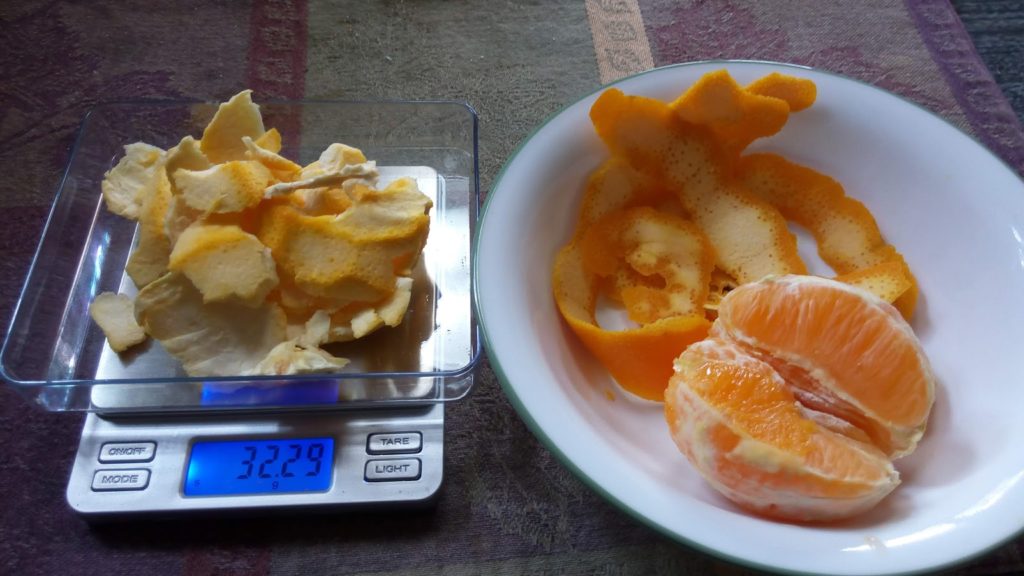Based on yield ranges in a review article (1), the whole citrus peel, colorful zest and white pith layers, contained across a variety of types of citrus, greater than 2000 micrograms/gram Fresh Weight (ug/gr FW) Quercetin Equivalents (group of similar chemicals), and 83-234 milligram/gram Fresh Weight (mg/gr FW) Hesperidin (for an average of 158.5 mg/gr FW). (1)
- An average size navel orange weighed 212.18 grams, ~ 7.5 ounces
- and yielded 32.48 gram orange zest peel, ~ 1 ounce
- 32.30 white pith peel, ~ 1 ounce
- 144.49 orange wedges, ~ 5.2 ounces
- small amount of unusable trimmings.
The citrus peel may contain 64 milligrams of quercetin and 5120 milligrams of hesperidin in the whole peel – the original measurements were of whole citrus peel (1) so it is unknown how much the white pith contains in comparison to the orange zest layer which likely contains more of the bitter tasting phytonutrients. Hesperidin was reported as being most prevalent of flavonoids being measured and equivalent across thin and thick skinned citrus species suggesting that more is in the thin zest layer (the flavedo) than the thick white pith layer (the albedo). (1, 4)
The white pith layer would likely contain a majority of the beneficial fiber and pectin, which makes up 64% of the whole peel of oranges, (1), or at least 21 grams of the yield of white pith or the orange zest in this example would be fiber/pectin. The jam in the last post had thickened even without the added pectin which led to it being too firm of a gel.

Health benefits may be provided from both types but in varying concentration. When I am feeling congested the pith of the whole orange is enough to clear the congestion and to help me breath more clearly again. See this post: Bitter taste receptors in the lungs & Hesperidin’s decongestant properties. Some of the zest is remaining on the white pith layer in small amounts too, but it is potent in flavor. The citrus peel jam in the last post is stronger in flavor than the white pith and a generous spoonful is plenty for a serving, and I usually mix it with other foods rather than eating it all at once.
The orange zest when minced made about a quarter cup/25 grams so the amount of 2 1/2 cups citrus zest in the jam recipe may have 250 grams potentially containing the majority of the 5120 mg of hesperidin per ounce – roughly 5000 x 10 1/4 cups = 50,000 mg for the 6 cup yield, 8,330 mg/cup or 1040 mg per two tablespoon serving of the Citrus Fig Marmalade/Jam, last post.
How much might be too much hesperidin? roughly about 28 oranges if 5120 milligrams were available with each pith layer of the peel that is eaten – however just one or two oranges per day, spaced out across the day, were good for my symptoms of congestion while I was ill, or when I am congested with spring allergies. The potentially Lethal Dose for 50% of lab animals for hesperidin, the LD50 dose, is 2000 mg/Kg. (2)
Hesperidin, rutin, citrus bioflavonoids are mildly estrogenic (so is resveratrol) and may be helpful against endometrial cancer. (2) Hesperidin may help against endometrial cancer cells by down-regulating estrogen receptors/progesterone & increasing apoptosis of the tumorous cells. (5) Bioflavonoids also seem to help reduce risk of Metabolic Syndrome, and related problems of obesity, high blood pressure, and insulin resistance, and reduce risk of cardiovascular problems. (3, 4, 6) Hesperidin can help reduce capillary fragility (6) – potentially preventing microvascular hemorrhages. More about the potential anti-viral and other health benefits of hesperidin and citrus bioflavonoids is in the post: Bitter taste receptors in the lungs & Hesperidin’s decongestant properties.
Disclaimer: This information is provided for educational purposes within the guidelines of Fair Use. It is not intended to provide individual guidance. Please seek a health care provider for individualized health care guidance.
Reference List
- Shafiya Rafiqa, Rajkumari Kaula, S.A.Sofi, et al., Citrus Peel as a Source of Functional Ingredient: A Review, J Saudi Society of Ag Sci, 17;4, Oct 2018, pp 351-358, https://www.sciencedirect.com/science/article/pii/S1658077X16300960
- Chapter 76 – Cardiovascular Effects of Hesperidin: A Flavanone Glycoside. Polyphenols in Human Health and Disease. Vol 2, 2014, pp 989-992. https://www.sciencedirect.com/science/article/pii/B9780123984562000761
- Assini JM, Mulvihill EE, Huff MW. Citrus flavonoids and lipid metabolism. Curr Opin Lipidol. 2013 Feb;24(1):34-40. doi: 10.1097/MOL.0b013e32835c07fd. https://www.ncbi.nlm.nih.gov/pubmed/23254473
- Bobbie Randall, RD. Citrus Albedo is Better Than You Thought, Jan 22, 2020, delgazette.com, https://www.delgazette.com/opinion/81450/citrus-albedo-is-better-than-you-thought
- Cincin ZB, Kiran B, Baran Y, B.Cakmakoglu. Hesperidin promotes programmed cell death by downregulation of nongenomic estrogen receptor signalling pathway in endometrial cancer cells. Biomedicine & Pharmacotherapy, Vol 103, July 2018, pp 336-345 https://www.sciencedirect.com/science/article/abs/pii/S0753332217332407
- Hesperidin/ScienceDirect, https://www.sciencedirect.com/topics/neuroscience/hesperidin CITRUS FRUITS | Processed and Derived Products of Oranges C.M. Lanza, in Encyclopedia of Food Sciences and Nutrition (Second Edition), 2003 // A Review of the Effects of Citrus paradisi (Grapefruit) and Its Flavonoids, Naringin, and Naringenin in Metabolic Syndrome Bibi Marjan Razavi, Hossein Hosseinzadeh, in Bioactive Food as Dietary Interventions for Diabetes (Second Edition), 2019
